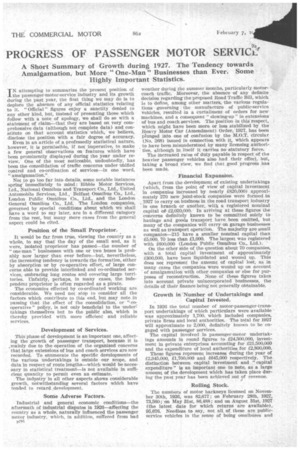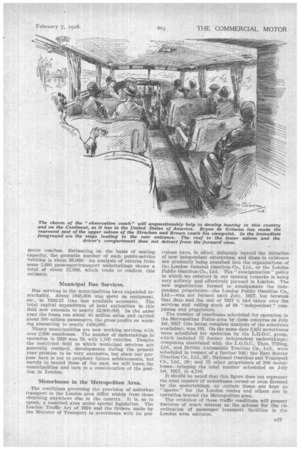PROGRESS OF PASSENGER MOTOR SERVIC?
Page 100

Page 101

If you've noticed an error in this article please click here to report it so we can fix it.
A Short Summary of Growth during 1927. The Tendency towards Amalgamation, but More "One-Man" Businesses than Ever. Some Highly Important Statistics.
IN attempting to summarize the present position of the passenger-motor-service industry and its growth during the past year, the first thing we may do is to deplore the absence of any official statistics relating to it. " Official " figures enjoy a sanctity denied to any other kind, but, instead of presenting those which follow with a note of apology, we shall do so with a statement of claim—that they are based on very comprehensive data (although not complete data) and constitute on that account statistics which, we believe, disclose the position with a fair degree of accuracy.
Even in an article of a professedly statistical nature, however, it is permissible, if not imperative, to make a few general observations on features which have been prominently displayed" during the year under review. One of the most noticeable, undoubtedly, has been the consolidation of traffic concerns under unified control and co-ordination of services—in one word, "amalgamation.".
Not to go too far into details, some notable instances spring immediately to mind : Ribble Motor Services, Ltd., National Omnibus and Transport Co., Ltd., United Automobile Services, Ltd., Belfast Omnibus Co., Ltd., London Public Omnibus Co., Ltd., and the London General Omnibus Co., Ltd. The London companies, governed by special conditions about which we shall have a word to say later, are in a different category from the rest, but many More eases from the general aspect could be cited.
Position of the Small Proprietor.
It would be far from true, viewing the country as a whole, to say that' the day of the small and, as it were, isolated proprietor has passed—the number of " one-man " businesses with one or two buses is probably now larger than ever before—but, nevertheless, the increasing tendency is towards the formation, either by absorption or by co-operative effort, of large concerns able to provide interlinked and co-ordinated services, embracing long routes and covering large territories. Unfairly, perhaps, in many cases, the Independent proprietor is often regarded as a pirate.
The economies effected by co-ordinated working are considerable. We need not stop to consider all the factors which contribute to this end, but may note in passing that the effect of the consolidation, or " cooperative " policy, is not only beneficial to the under: takings themselves but to the publiC also, which is thereby provided with more efficient and reliable services.
Development of Services.
This phase of development is an important one, affecting the growth of passenger transport, because it is ,mainly due to the operation of the organized concerns that large extensions of bus and coach services are 710101; recorded. To enumerate the specific developments of the various undertakings is outside our scope, and data in respect of route lengths—which would be necessary in statistical treatment—is not available in sufficient quantity to permit even an estimate.
The indpstry in all other aspects shows considerable growth, notwithstanding several factors which have tended to retard development.
Some Adverse Factors.
Industrial and general economic conditions—the aftermath of industrial disputes in 1926—a1ecting the country as a whole, naturally influenced the passenger motor industry, which, in addition, suffered from bad weather during the summer months, particularly motorcoach traffic. Moreover, the absence of any definite decision regarding the proposed Road Traffic Bill, which is to define, among other matters, the various regulations governing the manufacture of public-service vehicles, resulted in a curtailment of orders for new machines, and a consequent " slowing-up" in extensions of bus and coach services. The position in this respect, which might have been more or less stabilized by the Heavy Motor Car (Amendment) Order, 1927, has been plunged into one of confusion by the M.O.T. circular (No. 268) issued in connection with it, which appears to have been misunderstood by many licensing authorities, although in itself it carries no statutory force.
The increaSed rates of duty payable in respect• of the heavier passenger vehicles also had their effect, but, taking a broad view, we find that good progress has been made.
Financial Expansion.
Apart from the development of existing undertakings (which, from the point of view of capital investment in companies increased by nearly £820,000) approximately 270 new joint-stock companies were formed in 1927 to carry on business in the road transport industry in one branch or another, with a registered nominal capital oil £2,020,000. In arriving at these figures the concerns definitely known to be committed solely to haulage and goods transport have been omitted, but many of the companies will carry on garage businesses as well as transport operation. The majority are small companies-215 have a smaller nominal capital than £5,000, 70 less than £1,000. The largest was registered with £600,000 (London Public Omnibus Co., Ltd.). '
On the other side of the question about 70 companies, with a total capital investment of approximately J:300,000, have been liquidated and wound up. This does not represent the amount of capital lost, as in many cases the companies were wound up on account of amalgamation with other companies or else for purposes of reconstruction. None of these figures takes into account private unincorporated businesses, the details of their finance being not generally obtainable.
Growth in Number of Undertakings and Capital Invested.
In 1926 the total number of motor-passenger-transport undertakings of which particulars were available was approximately 1,700. which included companies, private firms and local authorities. The total for 1927 will approximate to 2,000, definitely known to be engaged with passenger services.
The capital involved in passenger-motor undertakings amounts in round figures to £24,300,000, investment in private enterprises accounting for £21,500,000 and the expenditure of local authorities for £2,800,000.
These figures represent increases during the year of £2,345,000, £1,700,000 and £645,000 respectively. The distinction between capital investment and "capital expenditure" is an important one to note, as a large amount of the development which has taken place during the past year has been achieved out of revenue.
Rolling Stock.
The numbers of motor hackneys licensed on November 30th, 1926, was 82,677; on February 28th, 1927, 73,560; on May 31st, 86,488; and on August 31st, 1927 (the latest date for which returns are available), 95,676. Needless to say, not all of these are publicservice vehicles in the sense of being omnibuses and motor coaches. Estimating on the basis of seating capacity, the probable number of such public-service vehicles is about 26,000. An analysis of returns from some 1,600. passenger-transport undertakings shows a total of .about 22,000, which tends to confirm this estimate.
Municipal Bus Services.
Bus services in the municipalities have expanded remarkably. About 1645,000 was spent on equipment, etc., ,in 1926-27 (the last available accounts). The total capital expenditure of local authorities in this field now amounts to nearly £2,800,000. In, the same year the buses ran about 40 million miles and carried about 300 million passengers, the gross profits on working amounting to nearly £450,000.
Ninety municipalities are now working services with over 2,300 omnibuses. The number of undertakings in operation in 1926 was 79, with 1,705 vehicles. Despite the restricted field to which municipal services are generally confined, developments during the present year promise to be very extensive, but since our purpose here is not to prophesy future achievements, but merely to record those of the past, we will leave, the municipalities and turn to a consideration of the position in London.
Matorbuses in the Metropolitan Area.
The conditions governing the provision -of motorbus transport in the London area differ widely from those obtaining anywhere else in the country. It Ls, so to speak, a reserved area under special legislation. The London Traffic Act of 1924 and the Orders made by the Minister of Transport in accordance with its pro
visions have, in effect, definitely barred the initiation of new independent enterprises, and those, in existence are gradually being absorbed into the organizations of the London General Omnibus Co., !Ad., or the London Public Omnibus Co., Ltd. The "amalgamation" policy to which we referred in our opening remarks is being very actively and effectively pursued in London. The new organization formed to amalgamate the independent proprietors---the London Public Omnibus Co., Ltd.—was not formed until July, 1927, but between that date and the end of 1927 it had taken over the services and rolling stock of 68 " independent " companies and proprietors. , The number of omnibuses scheduled for operation in the Metropolitan Police area by these concerns on July 1st, 1927 (the latest complete analysis of the schedules available), was 191. On the same date 3,851 motorbuses were scheduled for operation by the L.G.O.C. group, which included 57 former independent undertakings; co.mpanie,s associated with the L.G.O.C., Thos. Tilling, Ltd., and British Automobile Traction Co., Ltd., were scheduled in respect of a further 348; the East Surrey Traction Co., Ltd., 85; National Omnibus and Transport Co., Ltd., 29; and 75 other proprietors of 206 motorbuses—bringing the total number scheduled on July 1st, 1927, to 4,710.
It should be noted that this figure does not represent the total number of motorbuses owned or even licensed by the undertakings, as certain buses are kept as " spares " for the London routes and others are in operation beyond the Metropolitan area.
The evolution of these traffic conditions will present features of much interest as the scheme for the coordination of passenger transport facilities in the London area matures.




















































































































































































































